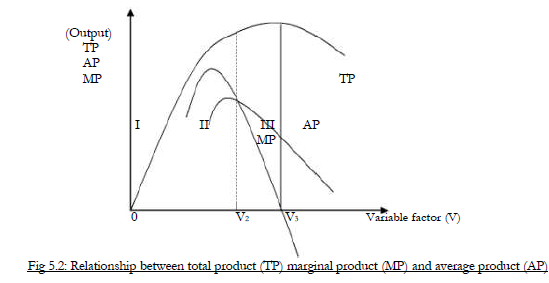The stages associated with the law of variable proportions are analysed while illustrating the relationship between total product, marginal product and average product.

Stage I:
Varying units of the variable factor input up-to OV2 , average returns of the variable factor is increasing. This
defines Stage I of production which is characterized by:
(i) Both the marginal product and average product are positive
(ii) Average product is increasing.
Rising average product does not mean that the variable input becomes more efficient but with more units of the variable factor, it is possible to utilize the fixed factor more efficiently for example, through specialization and division of labor in the case of workers.As long as average product is rising, efficiency is increasing thus at the employment of V2 units of the variable factor, the firm is at its most technically efficient level. The point is also defined by the intersection of the marginal product and average product curves.
(iii) Marginal product is initially increasing up-to a point where it reaches a maximum and then starts to decline. Marginal product rises as the fixed factor is utilized more efficiently.
(iv) Total product increases at an increasing rate as marginal product is rising and then it starts to increase at a decreasing rate as marginal products starts to fall.
(v) Stage I is said to be the stage of increasing returns.
Stage II:
Stage II begins where Average product starts to fall up-to the point where marginal product becomes zero.
This stage is characterized by the following:
1. Both marginal product and average product are declining. Marginal product is declining at a faster rate than average product.
2. Declining average product indicates decreasing returns and thus decreasing efficiency. This comes about because each additional unit of the variable factor has less of the fixed factor to work with.
3. Both marginal product and average product are positive,
4. Total product is increasing but at a decreasing rate.
5. Stage II is the stage of diminishing returns.
Stage III:
Stage III begins where marginal product becomes negative. It is characterized by the following:
1. Marginal product is negative and declining.
2. Average product is positive and declining.
3. Total product is declining.
Firms will avoid operating at Stage I as it involves utilizing a fixed factor inefficiently. Firms will also avoid Stage III as it involves falling total product since marginal product is negative. Firms will thus find Stage II economically efficient because marginal product and average product are positive although declining. Additional units of the variable factor will increase total product at this stage.
Stage I and Stage III are thus the irrational zones of production while Stage II is the rational zone of production.
Wilfykil answered the question on
February 7, 2019 at 06:17